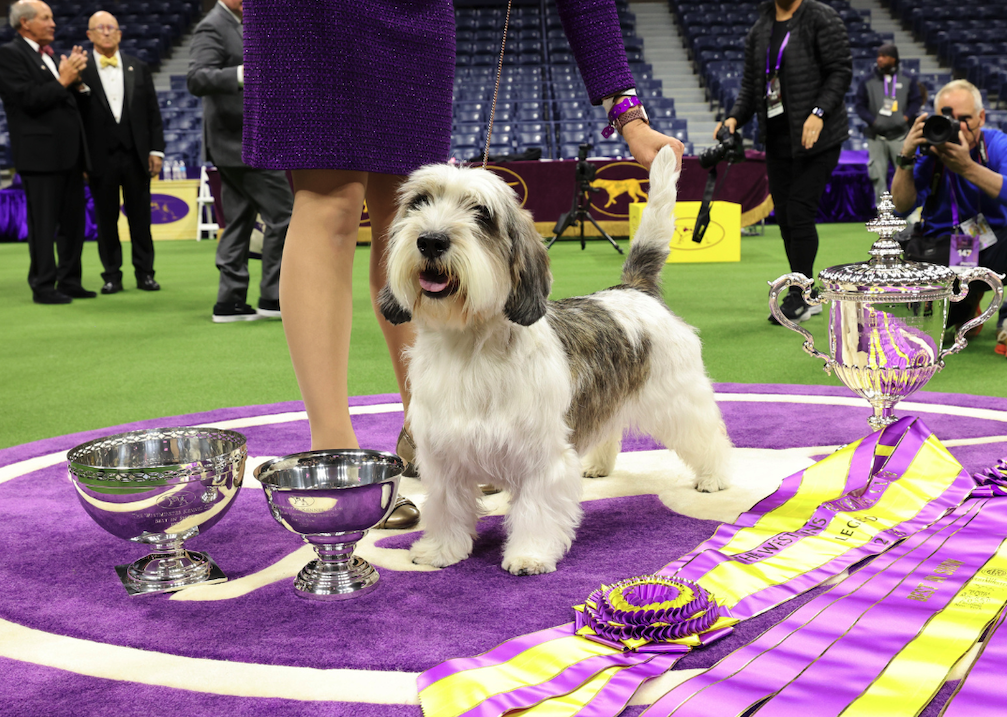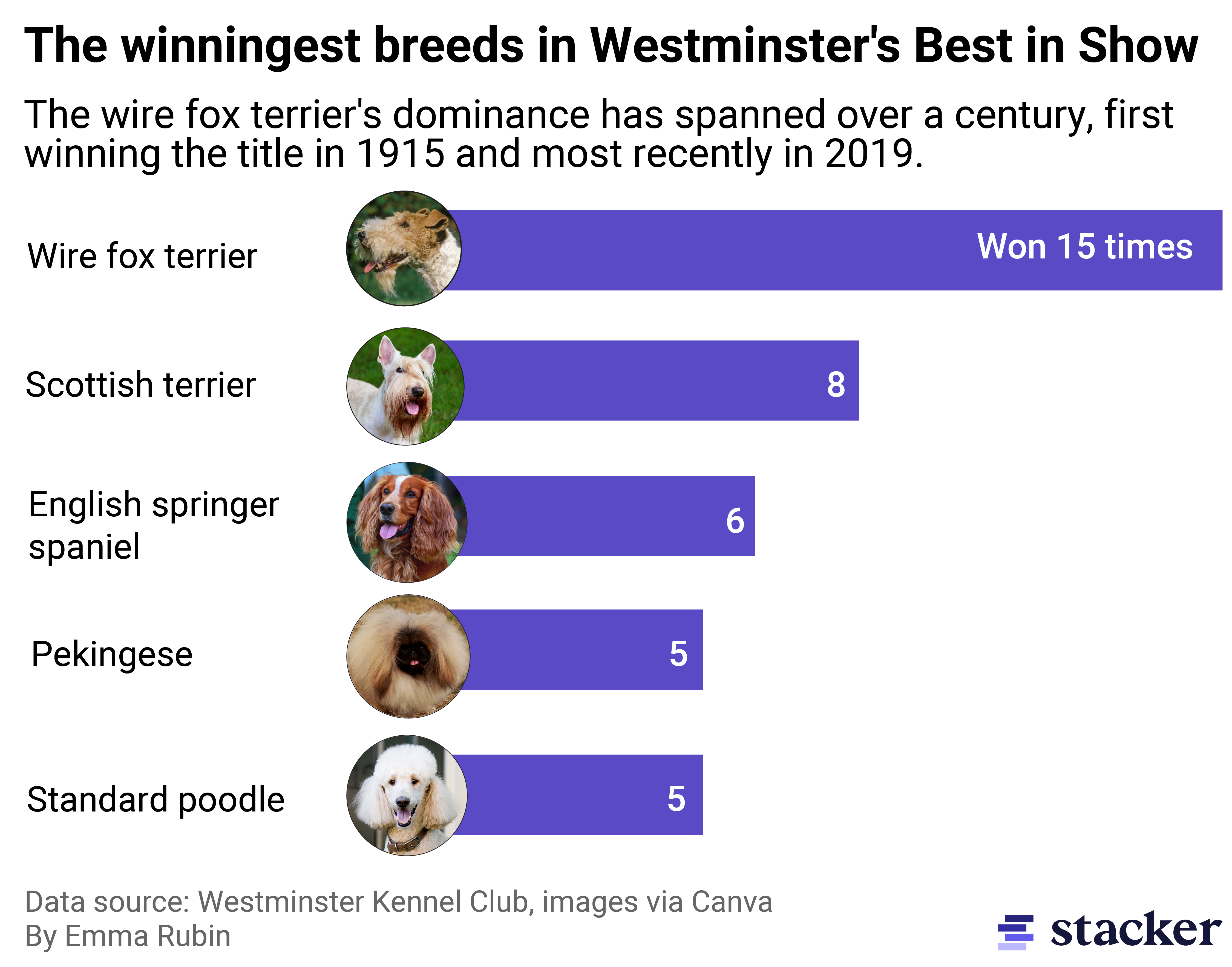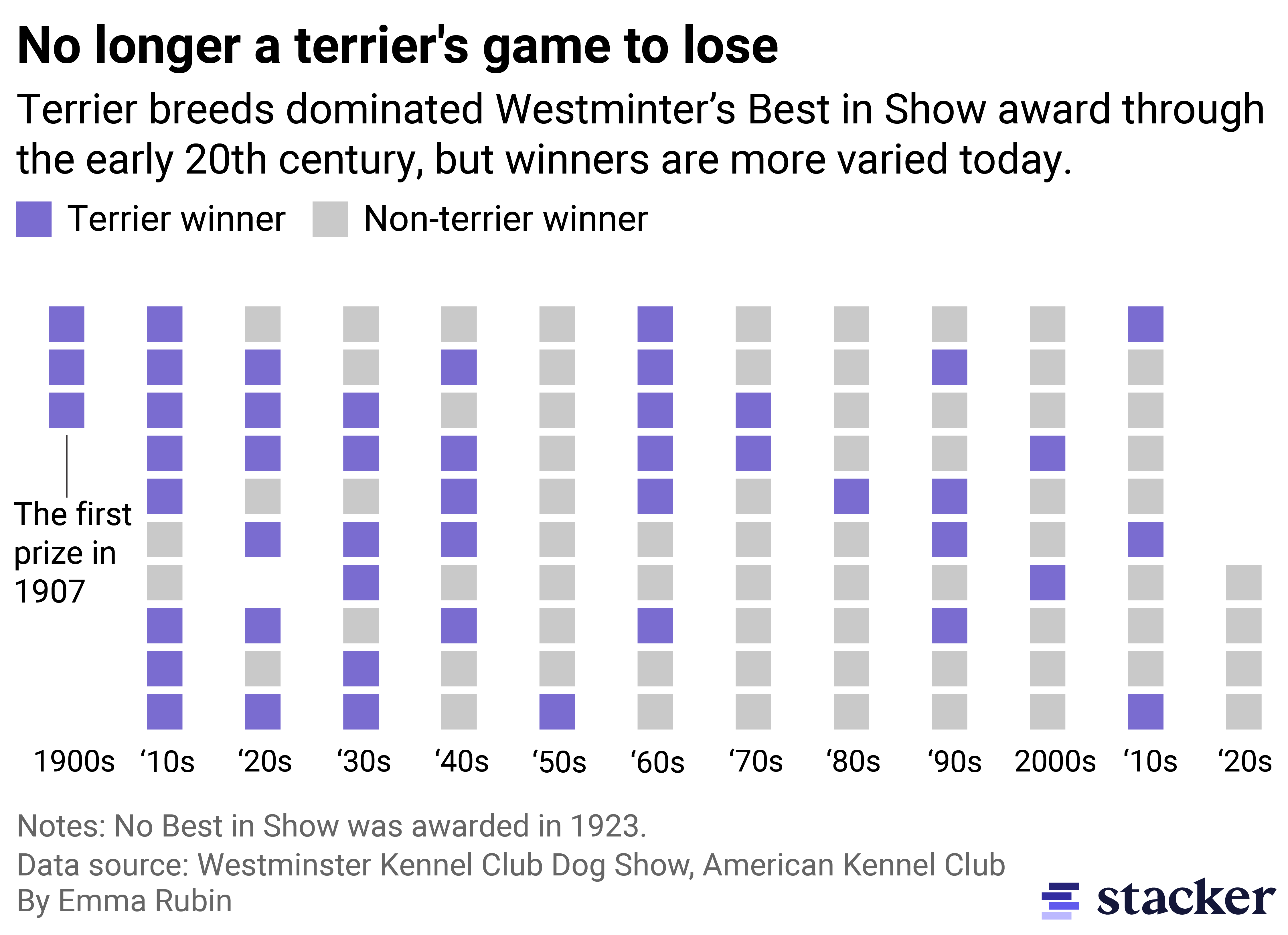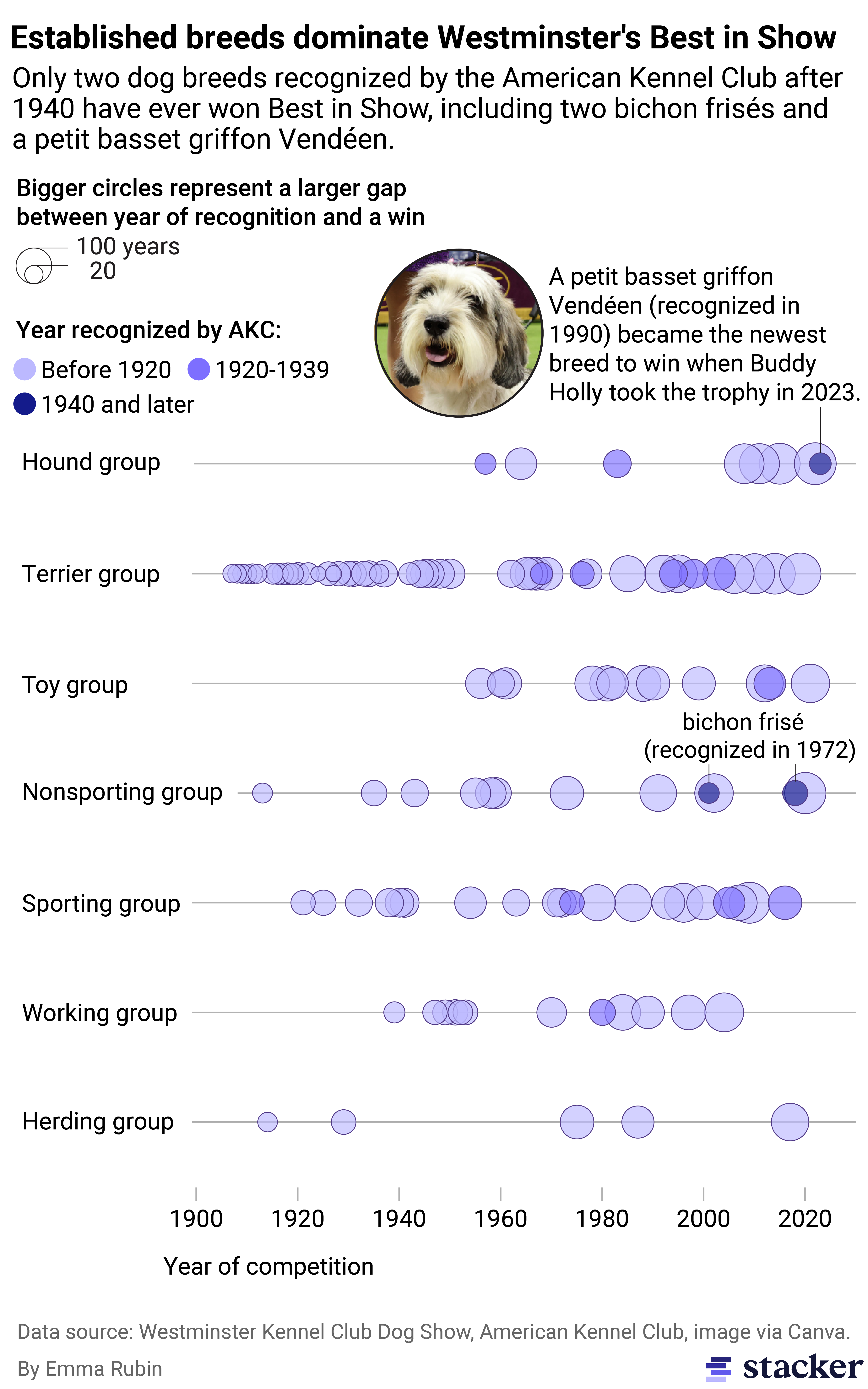What makes a Westminster Best in Show winner, based on a century of data

Cindy Ord/Getty Images for Westminster Kennel Club
What makes a Westminster Best in Show winner, based on a century of data
Buddy Holly, a petit basset griffon Vendéen, wins Best in Show at the 147th Annual Westminster Kennel Club Dog Show.
On the second weekend of May 2024, over 2,500 dogs representing every U.S. state and 12 countries will strut across rings at the USTA Billie Jean King National Tennis Center, each having spent countless hours training and preparing for the event. While leaving with any prize from one of the most competitive dog shows in the U.S. is already an achievement, the biggest honor of the day is Best in Show.
Only 116 dogs have ever won the competition’s most prestigious prize, representing 46 unique breeds. Stacker used data from the Westminster Kennel Club dog show and the American Kennel Club to explore trends in Best in Show winners since the start of the competition.
Just to qualify for the Westminster competition is a long journey. From an early age, owners balance dogs’ diets, time regular grooming sessions, clean their teeth, and train them to patiently stand while a judge examines them.
“That five minutes in the ring doesn’t seem like a lot, but to get them physically in condition both mentally and their muscle tone and their coat takes hours and hours each week,” Lori Pelletier, who will be judging breed competitions for terriers at Westminster this year, told Stacker.
The Best in Show award draws from the group division winners of each group, who are pulled from the winners of individual breed shows. When Wasabi, the 3-year-old Pekingese, won in 2021, he first beat out eight others of the same breed and then other outstanding toy breeds to eventually face off against six winners from other dog groups.
Judges compare each dog to the ideal version of their breed, officially called the Standard. These are two- to three-page documents that detail every breed’s “perfect” size, shape, and personality.
In German shepherds, for example, dark almond-shaped eyes, a muscular neck, and a powerful stride are some details judges will examine. Characteristics like a nose that isn’t mostly black or hanging ears would disqualify the competitor.
When Pelletier is judging terriers, she is not only comparing each dog to the standard; she’s looking for “terrier spirit.” In other words, she’s looking at how they move and present themselves relative to their historic roles as working dogs.
“The Norfolk and the Norwich [terriers] … have to have the spunk to go into a hole in the ground and corner that fox,” she explained.
Judges only spend three minutes with each dog close-up, but according to Pelletier, the judging starts as soon as each one steps into the ring. She immediately notes the breed type and whether it has an attitude that captures her attention.
![]()

Emma Rubin // Stacker
Some breeds regularly stand out to judges
Bar chart showing the winningest breeds at the Westminster Best in Show competition. A wire fox terrrier has won 15 times, followed by a Scottish terrier with 8 times.
Westminster’s most crowned breeds tend to diverge from what the American public favors for pets. Among the five breeds that have won Best in Show the most, poodles are the most popular. The AKC’s registration data shows both standard and miniature poodles were the fifth most popular breed in 2023.
The Best in Show award has eluded half of 2023’s 10 most popular breeds, with French bulldogs (#1), Labrador retrievers (#2), golden retrievers (#3), dachshunds (#6), and rottweilers (#9) never earning the prize.
Contrastingly, the dominant wire fox terrier is the 104th most popular out of the 200 listed breeds. Pelletier explained why wire fox terriers often stand out to judges. “To get a wire fox terrier to the level of being campaigned as a champion or as what we call a ‘special,’ it takes an incredible amount of work, and that work is usually rewarded,” she said.
Even beyond the Best in Show statistics, wire fox terriers have placed in the group competition 59 times since 1924, including 24 first-place wins.

Emma Rubin // Stacker
Why there are so many terrier winners
A chart showing the dominance of the terrier group’s dominance in Westminster’s Best in Show competition. They used to be the majority of winners in the early 20th century, but winners are more varied today.
Terriers were heavily favored during the first two decades of the Best in Show award at Westminster. The first winner of Best in Show was a smooth fox terrier named Warren Remedy in 1907, and she would go on to win the highest prize for the next two years as well.
The modern rules, which introduced five group competitions, first began in 1924. Hound and herding groups would be added in 1930 and 1983, respectively.
While terriers continue to be a popular choice for Westminster’s judges, they no longer account for most winners. Since 1980, they have won 10 Best in Show titles, with the sporting and toy groups closely behind at eight each. Herding groups have been the least dominant, with only two wins in that timeframe.
Not every terrier has had success, though: soft-coated wheaten and cairn terriers have both won the group in past competitions but fell short of the Best in Show titles. Border and Jack Russell terriers are among the breeds that have never won the terrier group.
Predictable grooming habits help make terriers ideal show dogs. “On a terrier, we can actually groom the dog and know that, in 12 weeks, this dog is going to be in perfect condition for Westminster,” Pelletier said.
By contrast, dogs like golden retrievers, which shed seasonally, can require more work to prepare for a May show.

Emma Rubin // Stacker
Newer breeds are the underdogs
A bubble plot showing established breeds dominate Westminster’s Best in Show competition. Only two breeds recognized by AKC after 1940 have ever won, two bichon frisé and petit basset griffon Vendéen.
The AKC has already recognized nearly 60 new breeds during the 21st century. By contrast, they recognized 94 new breeds throughout the 20th century.
Official AKC recognition can be a lengthy process, but it’s required to compete at high-level dog shows like Westminster. Although about 400 purebred dog breeds are recognized internationally, breeds must meet certain population and membership interest thresholds for AKC inclusion.
Beyond bichon frisé and the petit basset griffon Vendéen, other recently recognized dogs have come close to Best in Show success. The Havanese, recognized by the AKC in 1996, has won twice in the toy group since it first competed in 2000. Shar-pei were recognized by AKC in 1992, and the breed won the nonsporting group in 2011. Australian shepherds, recognized in 1991, won the herding group twice, most recently in 2023.
One new breed for 2024 will debut on the Westminster stage: the Lancashire heeler. With the herding group’s limited history in Best in Show successes and earlier-recognized breeds often dominating, the data suggests the heeler will be an underdog.
Story editing by Carren Jao. Copy editing by Paris Close. Photo selection by Michael Flocker.